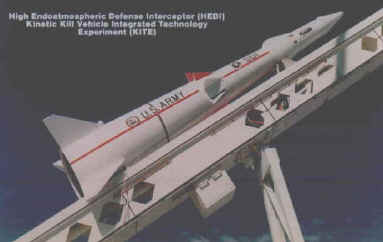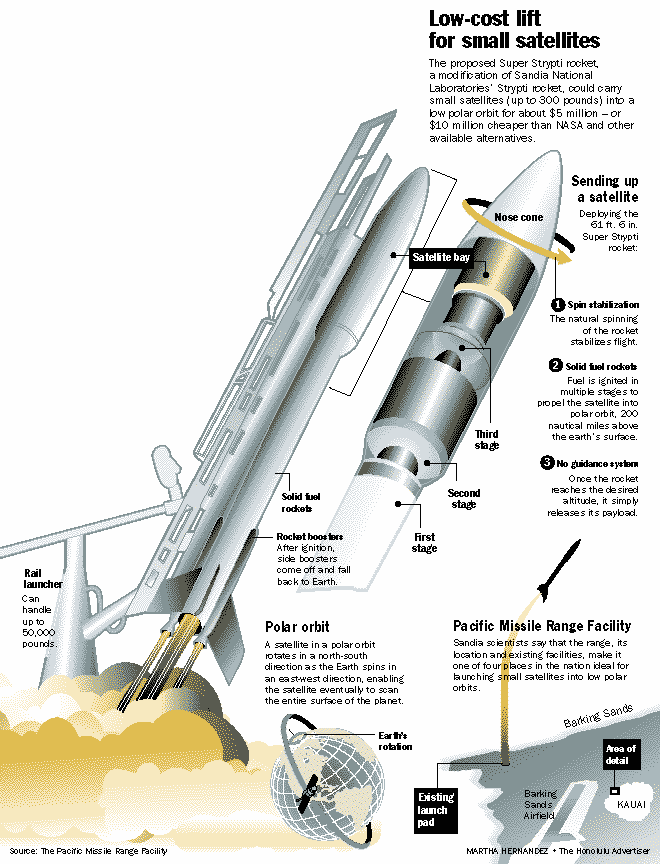SKY RAMP TECHNOLOGY
Sky Ramps can launch expendable rockets currently in use by making the first stage a reusable sled. This is not as desirable as an RLV, but is less costly to design and construct. The HEDI photograph below demonstrates this idea, although it is misleading since this ramp was only 40 feet long and used to launch the entire missile. One problem with liquid rockets is their casing must be strong enough to support the rocket standing on end full of fuel. Fuel tanks are pressurized during erection until they are fueled, otherwise they will collapse. Newer rockets like LockMart's Atlas V have stronger composite casings and require no pressurizing. However, a rail launched rocket could rest in a curved sled to provide it with great support. Once airborne, it has tremendous airflow around the body to support weight. Therefore, sled launched rockets could have much lighter casing, saving a few thousand pounds.
 The first step toward Sky Ramps is gaining acceptance that
rail launch is superior to vertical launch because a "dumb" booster
can be used for the first stage which does not require complex, expensive, and
redundant guidance and control mechanisms. A rail can allow the rocket to
be pointed at the exact azimuth and adjusted for winds just like cheap
sub-orbital sounding rockets used for tests and measurements. Large
rockets can be launched off a rail by scaling up the size of the launchers, which
can already launch 50,000lbs rockets.
The first step toward Sky Ramps is gaining acceptance that
rail launch is superior to vertical launch because a "dumb" booster
can be used for the first stage which does not require complex, expensive, and
redundant guidance and control mechanisms. A rail can allow the rocket to
be pointed at the exact azimuth and adjusted for winds just like cheap
sub-orbital sounding rockets used for tests and measurements. Large
rockets can be launched off a rail by scaling up the size of the launchers, which
can already launch 50,000lbs rockets.
In 1970, the Japanese rail launched the Lambda-4S to place a satellite into orbit. This first Japanese space launcher was 16.5 m high, weighed 9.5 tons and burned only solid fuel. The first stage was 73 cm in diameter and provided 363 kN during 28 seconds. It was assisted during the first 7 seconds by 2 solid fuel boosters of 255 kN thrust. The second stage (same diameter) provided 118 kN during 28 seconds. The third stage was 50 cm in diameter; it was capable of 64 kN during 27 seconds. The top stage was made of a 113 kg powder bloc providing 7.8 kN during 27 seconds which spherical shield made up the satellite's structure. The latter was only a technological capsule which mass at burn shutdown didn't exceed 23 kg. The vehicle was launched from an inclined ramp. It wasn't piloted; a gyroscopic system only controlled the fourth stage's altitude before ignition after the ballistic phase (which follows the third stage shutdown). On 11 Feb 1970 the Lambda-4S number 5 orbited a capsule named Ohsumi at 351 km x 5142 km x 31.2°. Japan continues to expand upon the simple rail launch technique with its latest M-V series of expendables.
In 2000, a team of scientists from Sandia National Laboratories released a detailed proposal for low-cost rail-launched to orbit satellites by increasing the size of their proven Strypi rockets. The proposed Super Strypi would be 62 feet, with added capacity through additional boosters. Strypi rockets use a rail and the spinning of the rocket itself to stabilize flight. "Simplification of design and operation is key to reducing cost and enhancing reliability", wrote Sandia scientists Eric Schindwolf, Bruce Swanson and William Millard in a paper on the launch of "Smallsats" using low-cost sounding rocket technologies. They would like to use the Navy launch facility in Kauai, Hawaii as this article explains. Sky Ramps may allow deletion of the booster, or use of the smaller Strypi rocket to launch Smallsats into orbit.

However, it seems that large booster makers have no interest in making low-cost boosters that would threaten their profits. Moreover, simple "dumb" boosters without complex guidance systems and movable nozzles could be made by dozens of less sophisticated companies which would drive profit margins down even more. Fortunately, grants from the US Air Force has allowed a small innovative company called Microcosm to rail launch low cost rockets. Microcosm is building a Scorpius rocket to put satellites in orbit. These low-cost proposals could cost even less if they use a Sky Ramp. A small Sky Ramp, like the Demonstrator proposed at China Lake, could allow them to Save-a-Stage. Once this is proven, political leaders and NASA must accept that single-stage to orbit RLVs can be launched into orbit off larger Sky Ramps.
©2008 Sky Ramp Technology